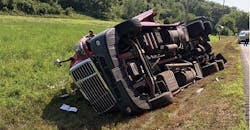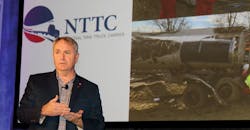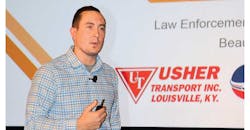Usher Transport safety personnel cover best practices for responding to tip-over incidents
USHER Transport doesn’t haul milk, but sometimes David Guess, Usher’s executive vice president of safety and human resources, wishes they did, particularly when one of their trucks is in an accident.
When their products spill, people could “blow up or disappear.”
“We’re a really good carrier, but we do have incidents happen,” Guess said.
Since tank trucks still are driven by humans who make mistakes, no fleet’s immune from roll-overs. But while many executives don’t want to acknowledge these unfortunate situations occur, which is understandable, Guess does, and he’s willing to share his company’s experiences.
He and Beau Mosley, Usher’s safety and loss control program director, discussed lessons learned and best practices developed in “Spilt Milk: Cleaning a Spill, Responding on the Scene & Aiding an Investigation” during the National Tank Truck Carriers’ Tank Truck Week 2018 in Nashville, Tennessee.
Guess’ first piece of advice—keep a go-bag handy.
When things go bad in the tank truck industry, they can go bad quickly, so fleet safety personnel must be ready to react rapidly. When the dreaded call that a chemical has spilled comes in, find out if the driver is alright, where the accident took place, what is the product—then hit the road.
There’s simply no time for crying.
“It’s very important to know the product,” Guess said. “I spent a few years prior to tank working in van freight, and when we put a load of paper towels on the side of the highway … it wasn’t too big of a deal.
“But when I got in the tank truck industry, and we put 7,000 gallons of no-lead gasoline in the middle of I-24, that suddenly became a really big deal.”
Over the road
While en route to a scene, Guess already is working it.
He’s on the phone tracking down as much information as possible, including who’s currently in charge and what’s their training.
“These are super important things we have to know, because sometimes they might not be fully trained to the level they need to be, so we have to walk them through different things,” Guess said.
Guess also makes sure to involve Usher’s insurer, while not letting them take over.
The company manages all its claims in conjunction with its insurance provider to maintain control of its money.
“If you’re working with a motor carrier where you say, ‘Hey this happened,’ and let the insurance company take care of it, I can tell you from personal experience that is a disaster … for your organization,” Guess said.
For incidents far from home, it’s good to have a network of helping hands.
That’s where NTTC’s “mutual aid society,” which allows members to call upon each other for assistance, comes in handy, not to mention the association’s many convention networking opportunities.
One call Guess doesn’t always make is to the National Response Center (NRC).
Usher’s policy is to avoid the NRC hotline if the incident involves a spill they can manage, and only management makes the call.
“When you have a spill and you can mop it up with a rag, don’t call that number,” Guess said. “We put that (number) in because it’s required to be there, but when you call that number … everybody from here to Alaska gets alerted, and they’ll all come to your scene because they all want to get paid.”
On the scene
After reaching the scene, touch base with everyone, including law enforcement, other first responders, tow trucks, rotators and even those opportunistic food trucks, and chase away non-essential personnel.
“Don’t keep anybody on scene you don’t need because they’re going to bill you,” Guess said.
Keep an eye on what everyone is doing and saying, write everything down and take plenty of pictures, because every tiny detail, no matter how small or seemingly inconsequential at the time, could be vitally important, particularly if there is an injury or fatality, or the incident ends up in litigation.
And don’t forget about the driver.
If they left the scene, stay in touch with them and their family members, who could show up, potentially complicating the situation, and if they’re on the scene, keep them involved, and out of media’s hands.
Along those lines, Guess also advised keeping garbage bags and duct tape in those go-bags for covering up the name on the truck, helping limit potentially negative exposure to curious passers-by.
When dealing with law enforcement, establish a cordial relationship.
Working together, not at odds, makes a stressful situation more tolerable, so prepare for that post-crash inspection because their help may be needed later. And remember, traffic control isn’t law enforcement’s responsibility. It’s civilian work, so quickly determine who are the local “cone and barrel” people.
Keep everyone off-scene apprised, including the customer whose product spilled, the operations team, dispatchers and especially ownership, because it’s always bad when they hear it in the news first.
Finally, training, training and more training.
Every chemical comes with unique properties and dangers, creating different hazmat scenes that necessitate specific responses, so a company’s safety personnel, and ideally every employee, should have all relevant certifications, and access to vital equipment, including suits, gloves, goggles, etc.
“Whenever you’re planning emergency response, you’ve got to be trained,” Guess said. “You’ve got to know what you’re doing because if you don’t … somebody’s going to get hurt or killed.”
Conflicting goals
Mosley spent six years with the Kentucky State Police, where he worked in commercial vehicle enforcement, so he’s experienced incident response from both sides, giving him a unique perspective.
He says the goals of industry and law enforcement typically align, but not always.
“From an industry side, we’re worried about that product,” Mosley said. “Somebody owns it. It’s the customer’s, and we’ve got to clean it up and pay for it. Law enforcement looks at that differently. They want to know what it is and if it will harm anybody. Outside of that, they’re not that concerned with it.”
Law enforcement objectives include preserving life, limiting exposure, protecting the scene, investigation, reconstruction, vehicle inspection, removal of involved vehicles, and reopening the roadway.
Industry shares many of those goals, but businesses also must consider damage to their equipment, and if it’s repairable, other involved parties, product loss, environmental impact, liability and cost.
When it comes to money, Mosley said law enforcement goals align better with public perception that trucking companies can pay for anything, and their priority is cleaning up the spill as quickly as possible, so they’ll call anyone and everyone to help, leaving the carrier with a mountain of bills.
But everyone can agree maintenance is the key to relieving many a headache.
Not only is regular upkeep “extremely important” for safety, and avoiding many tip-over situations altogether, but it also can save a company time and money if an incident enters the legal system.
“You look at a situation where maybe you’re not the at-fault party, and then (law enforcement) gets into the (post-accident) vehicle inspection and finds brakes out of adjustment, or the tire tread depth is off, now something that seemingly was not your fault and straightforward could potentially be your fault, especially when a defense attorney gets ahold of it,” Mosley said. “If it goes to litigation, don’t think for a minute they’re not going to bring up every violation that trooper finds.”
The process
Mosley divided law enforcement incident management into five steps—response, scene protection, investigation, recovery and documentation—with key considerations that apply to carriers, too.
Response questions include how many vehicles are involved, are hazardous materials present, what are they and the associated risks, who’s on scene and is the roadway blocked, which is a huge concern for officers charged with alleviating the traffic that’s worsening every second on a busy roadway.
“It’s all about communication, really, at the end of the day,” Mosley said.
To protect the scene, roads may need to be closed, traffic diverted, and perimeters established to control access.
Sometimes these efforts work against the company involved.
“There are some potential road blocks,” Mosley said. “Maybe you can’t get to your driver, can’t see the truck, can’t take photographs, and these are all things you need to work through and be prepared for. Is your driver trained properly? If this happens, and you can’t get to the scene, does the driver have a plan, and does he know to take pictures, what to look for (and) to get witness statements?”
Then comes an investigation, which can include driver interviews, witness statements, dash camera reviews, scene analysis, photos, measurements, reconstruction, equipment inspection and establishing causation.
Recovery involves removing equipment and re-opening the roadway, and can take anywhere from a few hours to a few months.
Mosley said companies should prepare for the process to take longer than they’d prefer.
“What if your equipment’s put on legal hold?” Mosley said. “I’ve worked collisions that are total losses, just absolutely destroyed, nothing left, and I’ve also worked rollover collisions where the truck and trailer can be repaired. If you have that truck and trailer, most likely you need that truck and trailer, and want to get it fixed. You want to get it to the vendor,
get it repaired and get it back on the road, because if it’s on the road it’s making money, and if it’s sitting there it’s not.
“But be prepared because it could be placed on a legal hold for months.”
Collision reports, too, can take weeks to complete, depending on the complexity of the situation. Oftentimes, pertinent information isn’t available until a later date, and scene reconstructions are tedious, time-consuming processes that can’t be rushed, especially if the collision is severe.
And when the report finally is received, be sure to check it twice.
Violations resulting from the accident, such as broken headlights, flat tires and bent wheels, don’t count as heavily against a company’s federal safety score—if they’re properly marked on the report.
Finally, Mosley recommends post-collision procedures include reading the collision report, carefully inspecting for errors, verifying facts and conducting an internal investigation, instead of relying exclusively on others.


